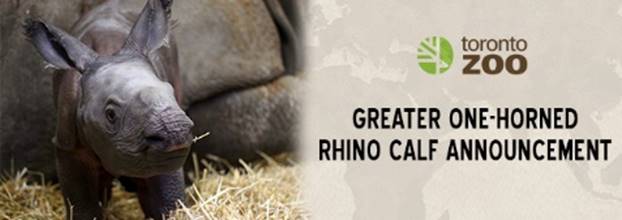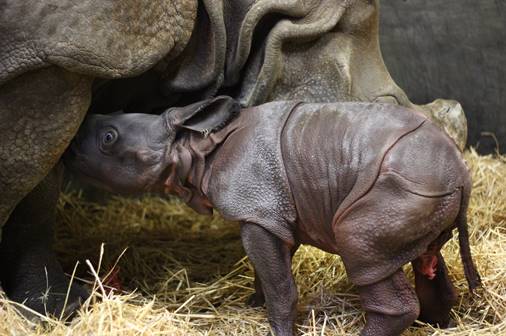
TORONTO ZOO WELCOMES
2nd RHINO CALF BIRTH

Photo Credit: Toronto Zoo
FOR VIDEO OF THE GREATER ONE-HORNED RHINOCEROS CALF NURSING:

TORONTO, ON, Monday, January 8, 2018: The Toronto Zoo is very proud to announce that Ashakiran, a 13 year-old female greater one-horned rhinoceros (rhinoceros unicornis), gave birth to a male calf on Thursday, January 4, 2018 at 11:04 am. This is the first birth of 2018 for the Toronto Zoo.
This recent birth is very important for greater one-horned rhino conservation, also known as the Indian rhino, as the species is currently listed as Vulnerable on the International Union for Conservation of Nature (IUCN) Red List of Threatened Species and there are only approximately 3,500 left in the wild. Declined to near extinction in the early 1900’s the greater one-horned rhino was once listed as Endangered however, with conservation efforts and strict protection, it was down listed to Vulnerable. This is considered a conservation success story but they are not out of the woods. Habitat degradation, human rhino conflict, and poaching continue to be threats. The greater one-horned rhino exists in a few small subpopulations in Nepal and India (West Bengal, Uttar Pradesh, Assam) inhabiting the riverine grasslands of the Terai and Brahmaputra Basins. With 70 % of the wild population occurring in one area in Kaziranga National Park, any catastrophic event could have a huge impact on conservation efforts for this species.
A greater one-horned rhino’s gestation lasts 425 - 496 days (approximately 16 months) and a single young is born. Subsequently, Ashakiran, affectionately known to her keepers as "Asha", was moved from public viewing into a maternity area within the Greater One-Horned Rhino Habitat mid-December, where video cameras were set in place for Wildlife Care to monitor her closely. While the calf appears healthy, and feeding well, the first thirty days will be critical for both mom and calf. Toronto Zoo Wildlife Care staff will continue to closely monitor Asha and her calf in the maternity area, which is not visible to the public at this time.
This is the second calf for Asha and Vishnu, father and 14-year-old male. Asha gave birth to male Nandu on February 17, 2016. This is the fifth birth of a greater one-horned rhino in Toronto Zoo's history.
“Given that this is Asha’s second offspring, we are thrilled that she continues to reproduce and contribute to a genetically healthy population,” says Maria Franke, Curator of Mammals, Toronto Zoo. “Rhinos around the world are under increasing pressure due to habitat loss and poaching for their horn. It is important to educate the public on their plight in the wild and do everything we can to prevent the threats they face and halt declining populations.”
The Toronto Zoo is part of the Greater One-Horned Rhino Species Survival Plan (SSP), which aims to establish and maintain healthy, genetically diverse populations, and overall conservation efforts to save this incredible species. One of the Toronto Zoo's mandates is to educate visitors on current conservation issues and help preserve the incredible biodiversity on the planet. The Toronto Zoo supports rhinoceros conservation efforts in the wild through keeper driven events and the Toronto Zoo Endangered Species Reserve Fund.
Please note, Asha and her calf are not currently visible to the public.
Toronto Zoo Media Contact:
Katie Gray, Supervisor of Public Relations and Events
[email protected] or #416-392-5941
Amanda Chambers, Public Relations and Events Associate
[email protected] or #416-392-5974